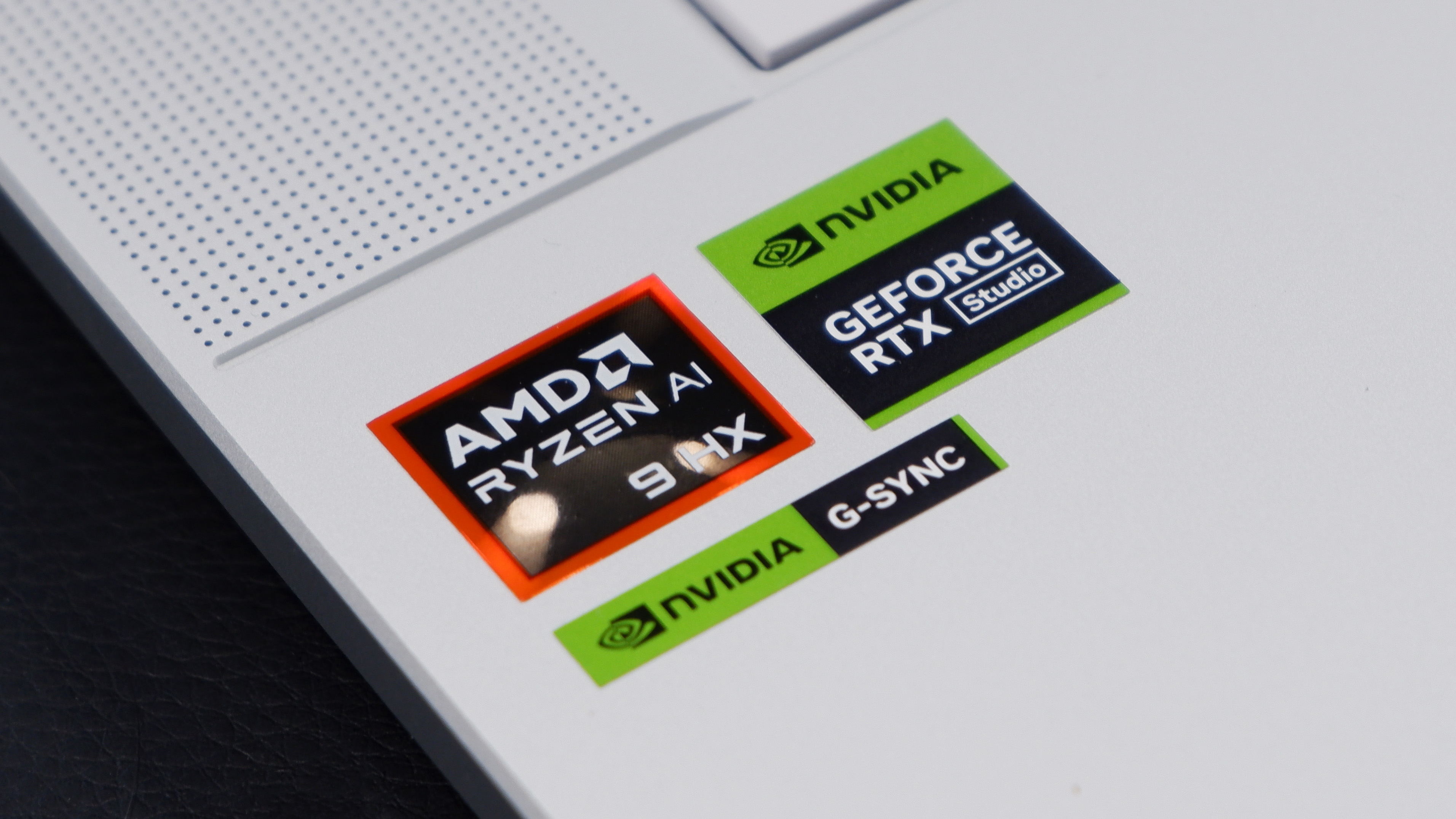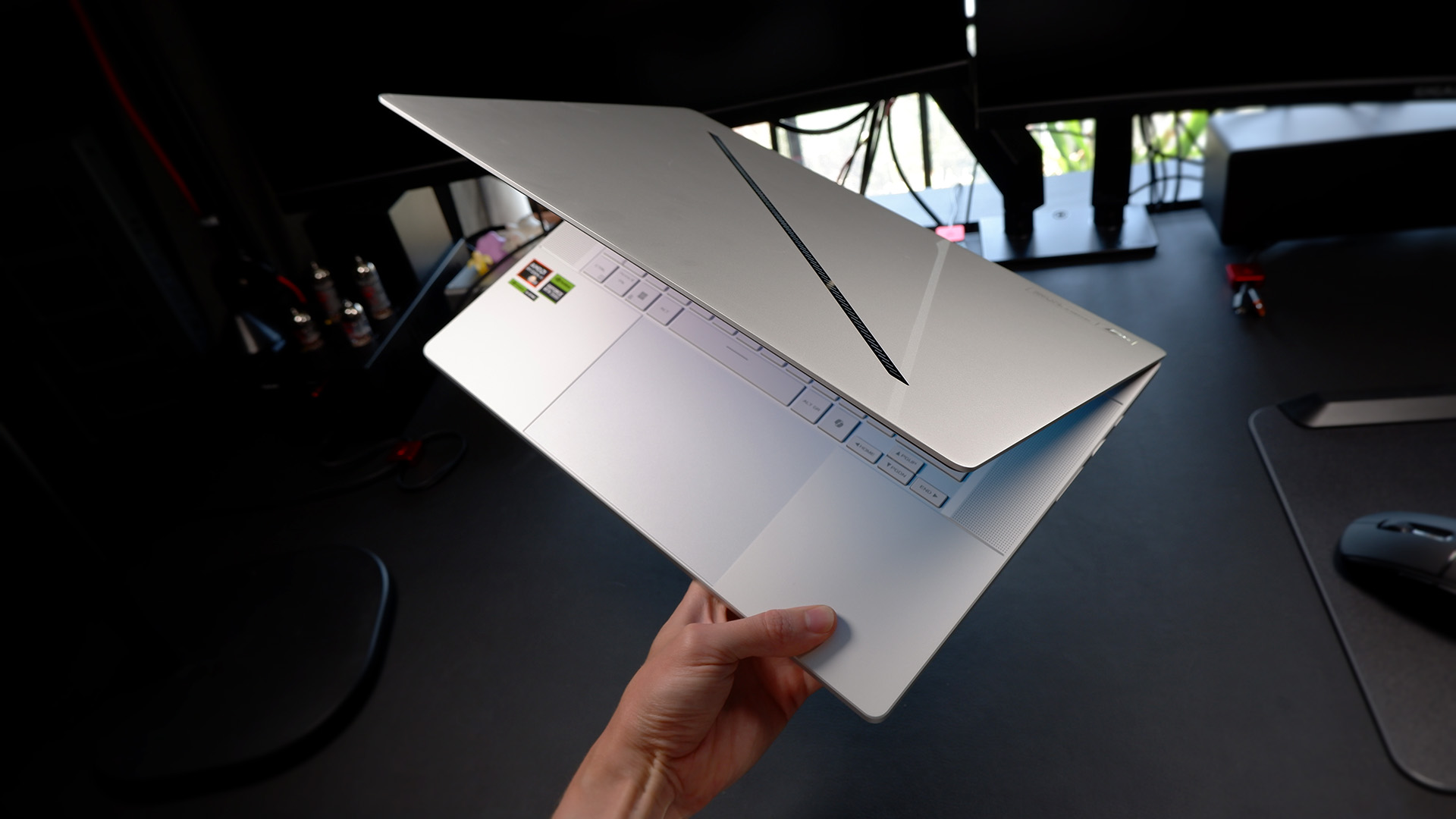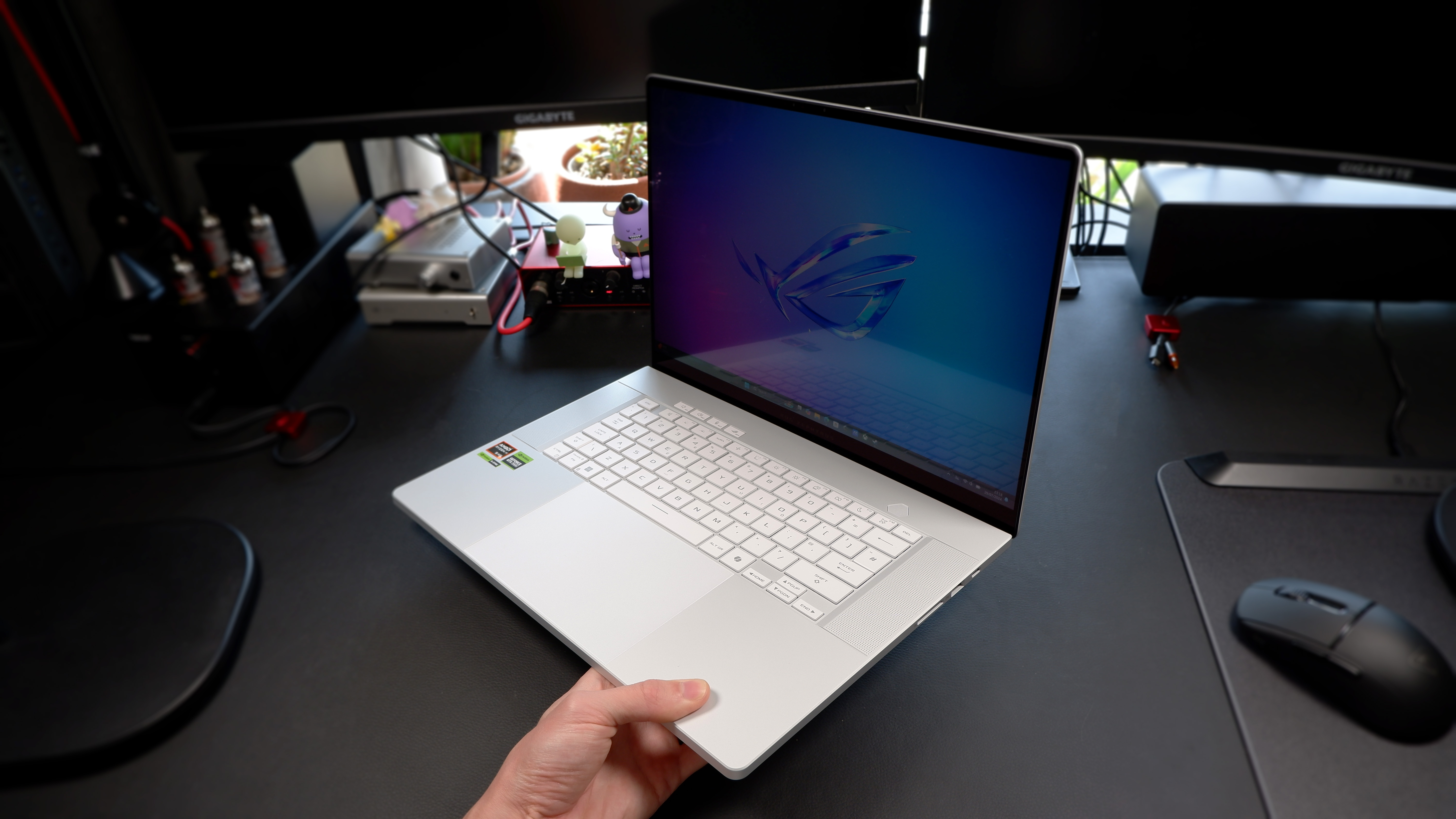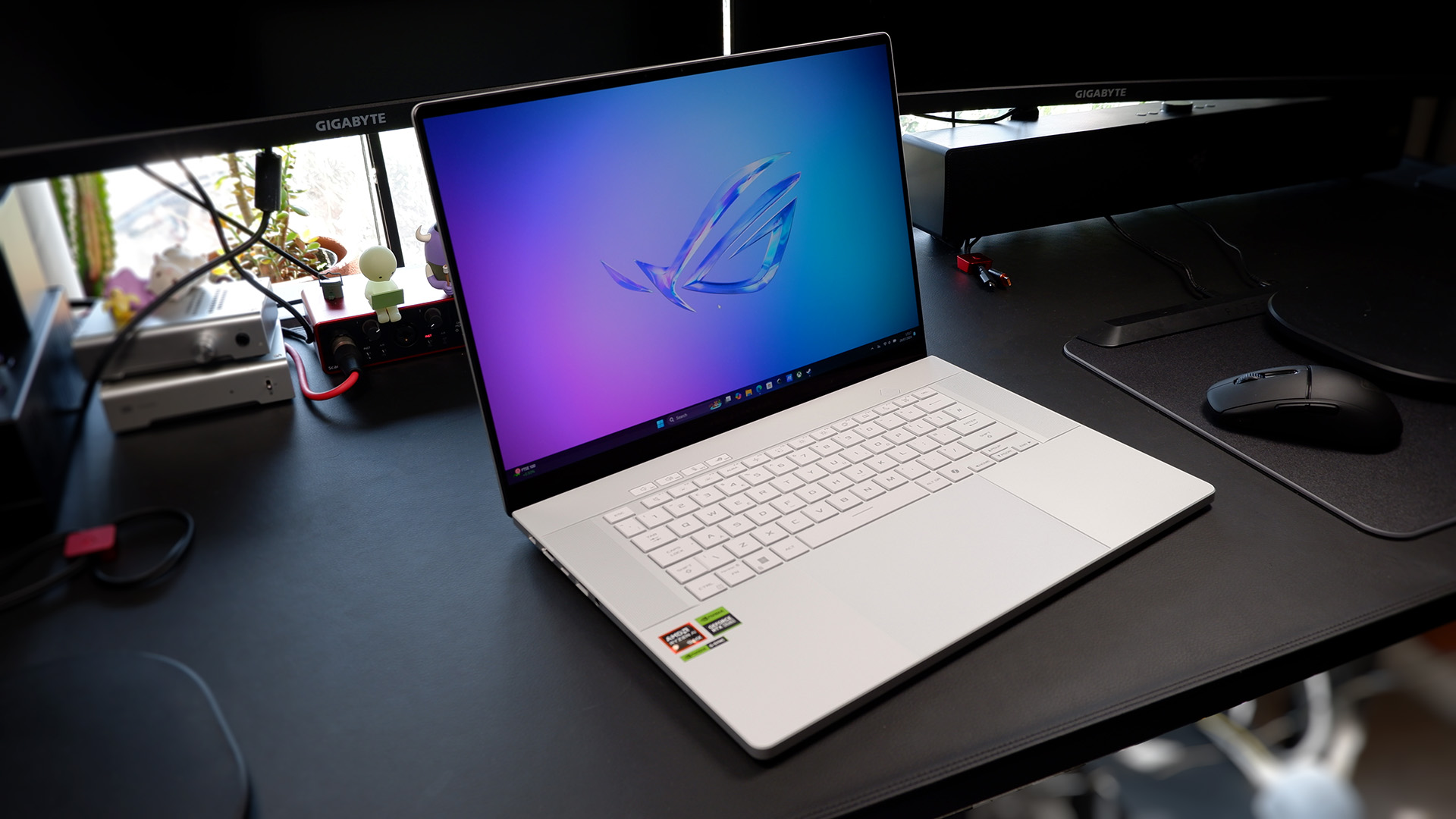Our Verdict
The gaming laptop I'd buy today. All thanks to a carefully balanced spec sheet, gorgeous chassis, and punchy display.
For
- Superb chassis design
- Slim size
- Punchy OLED screen
- Responsive trackpad
- Great speakers
- Solid performance
- Spare NVMe slot
Against
- You could buy a faster RTX 4070 laptop
- Soldered RAM
PC Gamer's got your back
The ROG Zephyrus G16 is a lovely thing. A 16-inch laptop with an aluminium chassis, vibrant OLED screen and genuinely decent speaker system—it's easy to see why it's coveted by so many. Though we've reviewed this laptop before and come to much the same conclusion, before me sits a new model. This is the G16 GA605, and it comes with a new AMD Ryzen AI HX 370 processor inside it.
I've run through what's new in AMD's Ryzen AI 300-series in greater detail in my recent story all about testing AMD's Strix Point chip. But let me quickly break it down for you here:
- New cores: Inside the HX 370 are two new architectures, Zen 5 and Zen 5c. They're pretty much the same except the four Zen 5 cores have access to 16 MB of L3 cache, whereas the eight Zen 5c cores just 8 MB.
- New iGPU: One of the best bits of the new HX 370 chip is the Radeon 890M integrated GPU. With four more than the previous generation's 780M and an improved architecture, RDNA 3.5, it's a step-up for low-power 1080p gaming.
- New NPU: Is this a benefit for gamers? I'm not convinced there's for gamers to get out of this new dedicated AI acceleration block just yet. Many of the AI applications you may use are also accelerated by Nvidia's GPUs, and there's one of those inside most gaming laptops. But it's still early doors for good ol' locally-processed AI.
Got all that? A great deal of new silicon stuffed inside one monolithic mobile processor, that's for sure, and it shows when it comes to the benchmarks as we'll get to shortly.
But let's look at the Zephyrus G16 itself. It offers a thin chassis for a 16-inch laptop, which even at its thickest point including the rubber feet, by my own measurements, is just 2 cm thick. It tapers down to a thickness much thinner than that, though. It also weighs just 1.8 kg, which is great considering its 16-inch size.

CPU: AMD Ryzen AI HX 370
GPU: Nvidia GeForce RTX 4070 (105 W)
Memory: 32 GB LPDDR5X 7467 RAM
Storage: 2 TB NVMe SSD
Screen size: 16-inch ROG Nebula OLED
Resolution: 2560 x 1600
Refresh rate: 240 Hz
Battery: 90 Whr
Dimensions: 35.4 x 24.6 x 1.49 ~ 1.74 cm
Weight: 1.95kg (4.29 lbs)
Price: $2,300 | £2,400
The G16 is slim and light enough to slip into my backpack without much of a second thought. I've taken it to and from the office and once found myself checking I hadn't been robbed on the bus because my backpack felt suspiciously light. Not to worry, it was still there—I managed to avoid a very awkward conversation with Asus—though this laptop was light enough to make me second guess myself. For a regular traveller that lightweight frame is awfully appealing.
The chassis is made possible through the use of LPDDR5X memory. This is a type of RAM we more often expect to find in office thin-and-light laptops, though increasingly it is becoming commonplace in gaming devices, namely handheld gaming PCs but also some thinner gaming laptops, such as this. The reason it's not so frequently used in gaming machines is due to the fact it's non-replaceable—or at the very least non-replaceable without some industrial soldering techniques. You can't just replace the RAM in this laptop yourself.
The non-replaceable RAM is definitely one of the bigger downsides to the G16. The 32 GB capacity is more than enough for my uses and I'm unlikely to want to upgrade that down the line, but I know opinion swings wildly person-to-person on this. I said the same thing in my Zephyrus G14 (2024) review, as both new models have fully soldered memory.

That said, whereas the G14 only has a single NVMe slot and it comes occupied by the boot drive, the G16 comes with a spare. Phew. That saves a lot of hassle when upgrading the storage capacity on this thing, which isn't bad out of the box at 2 TB but could always be bigger. Removing the underside of the laptop is a bit of a pain, as the clips holding the rear on are quite stiff, though with a bit of luck and muscle you'll do alright.
There are a few areas where the G16 is surprisingly stellar. One is the speaker system, complete with reasonably large woofers (for a laptop).
To avoid relitigating Andy's ROG Zephyrus G16 review for the RTX 4090/Intel Meteor Lake model, I'll instead broadly agree with his sentiment: "these are actually surprisingly punchy. While I wouldn't go as far as to say they could replace a portable Bluetooth unit, unlike most laptop speakers I've heard they actually have some genuinely meaningful bass and mid-range, enough to give you a bit of a kick underneath your wrists when listening to music or cranking up the game audio."
Well said, Andy.
Another area of excellence is the trackpad. Obviously it's huge, at 15 x 10 cm, but it's hella responsive too. My only complaint here is that the deadzone for the physical trackpad click is quite large, at around 1.5 cm from the top of the trackpad, though it isn't such an issue on a trackpad of this size.

The OLED screen is another highlight. It's a Nebula Display, according to Asus, which is a fancy name for a 16:10, 240 Hz glossy OLED. Whatever you want to call it, it's gorgeous for gaming. What I find more than anything is how much I appreciate the larger 16-inch screen size when playing competitive shooters, which this speedy 0.2 ms panel is well cut-out for. The 14-inch panel is convenient as all heck but 16-inch feels like a much more natural fit for FPS gaming.
What's left to comment on but the GPU? Usually the star of the show, the RTX 40-series is a well-known quantity by now. This laptop comes with an RTX 4070 rated to 105 W. That's lower than some we've tested, including the Gigabyte Aorus 16X at 140 W and Lenovo Legion 7i 16 Gen 9 at 130 W. The slimmer power budget does make a difference when it comes to game performance, as you can see in the charts below.
The G16 can be anywhere between less than 1% slower and 10% slower than the Lenovo Legion 7i, despite containing the same GPU. The Legion does come with a beefier Intel CPU, however.
The G16's power-savvy RTX 4070 does have the benefit of allowing for quieter, less intensive cooling. It's also a boon to battery. However, Asus has trimmed down the G16's thickness to such an extent that this RTX 4070 actually runs hotter than most we've tested. That's despite three fans and liquid metal from Thermal Grizzly. That's not really a massive surprise, but it shows you're paying for this laptop's thin chassis in more ways than one.
✅ You want a sleek frame: The G16 packs a 16-inch screen in a laptop that feels much thinner and lighter than you'd expect for the screen space.
✅ You want to work and play on the same device: A big screen, compact form factor and lovely chassis makes this as good a fit for office life as it is sat on a gaming desk.
❌ You want top performance from the GPU: The G16 does a smashing job considering its size, though there are moderately larger laptops with higher performance on offer from the same componentry.
❌ You want upgradeable RAM: The G16's slim size comes at the cost of upgradeable memory. Providing you get 32 GB out of the gate, that's not such a worry, though some might not like the restriction. At least there's a spare NVMe SSD slot in this model.
This model with an RTX 4070 inside it is is preferable to the alternative, which is an RTX 4060. The RTX 4060 will age quicker and you're stuck with your choice of chip in any gaming laptop. You could buy an RTX 4070 gaming laptop from another manufacturer for less than the price of either model of G16, too—so I'm not sure there's really a 'budget option' to be had here. Stick with the RTX 4070 and you'll go just fine, however.
But it's time to face the music. Pricing is a big factor in the gaming laptop biz, and Asus knows it has a competitive package in the G16, even compared to stalwart premium models from Razer. It's asking for $2,300 for our American friends, and while I'm yet to find a specific listing, I'm told it will start out at £2,400 in the UK.
That's a lot of cash, even by gaming laptop standards.
I can see where the money goes, and compared to premium offerings from Razer and the larger 16-inch Blade models, the G16 is not that expensive. Though you are undeniably paying for that luscious chassis, sleek form factor and gorgeous screen. That feels a fair deal, and this sensible RTX 4070 and Ryzen AI combo more so than the slightly absurd RTX 4090/14900HS model our Andy reviewed initially.
No doubt if I could pick any gaming laptop to buy with a view to working across both my gaming and work lives, it'd be the Zephyrus G16. And in this exact spec—shame I'll have to send it back almost imminently, then, isn't it?
The gaming laptop I'd buy today. All thanks to a carefully balanced spec sheet, gorgeous chassis, and punchy display.

Jacob earned his first byline writing for his own tech blog. From there, he graduated to professionally breaking things as hardware writer at PCGamesN, and would go on to run the team as hardware editor. He joined PC Gamer's top staff as senior hardware editor before becoming managing editor of the hardware team, and you'll now find him reporting on the latest developments in the technology and gaming industries and testing the newest PC components.


